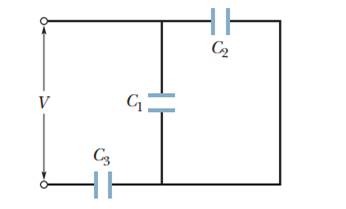
Concept explainers
In Fig. 25-29, a potential difference V = 100 V is applied across a capacitor arrangement with capacitances C1 = 10.0 μF, C2 = 5.00 μF, and C3 = 15.0 μF. What are (a) charge q3, (b) potential difference V3, and (c) stored energy U3 for capacitor 3, (d) q1, (e) V1, and (f) U1 for capacitor 1, and (g) q2, (h) V2, (i) U2 for capacitor 2?

Figure 25-29 Problems 11, 17, and 38.
Trending nowThis is a popular solution!

Chapter 25 Solutions
Fundamentals Of Physics 11th Edition Loose-leaf Print Companion Volume 2 With Wileyplus Card Set
Additional Science Textbook Solutions
Human Biology: Concepts and Current Issues (8th Edition)
Human Physiology: An Integrated Approach (8th Edition)
Campbell Biology (11th Edition)
Biochemistry: Concepts and Connections (2nd Edition)
Applications and Investigations in Earth Science (9th Edition)
Introductory Chemistry (6th Edition)
- (i) Rank the following five capacitors from greatest to smallest capacitance, noting any cases of equality, (a) a 20-F capacitor with a 4-V potential difference between its plates (b) a 30-F capacitor with charges of magnitude 90 C on each plate (c) a capacitor with charges of magnitude 80 C on its plates, differing by 2 V in potential. (d) a 10-F capacitor storing energy 125 J (e) a capacitor storing energy 250 J with a 10-V potential difference (ii) Rank the same capacitors in part (i) from largest to smallest according to the potential difference between the plates, (iii) Rank the capacitors in part (i) in the order of the magnitudes of the charges on their plates, (iv) Rank the capacitors in part (i) in the order of the energy they store.arrow_forwardWhat If? The two capacitors of Problem 13 (C1 = 5.00 F and C2 = 12.0 F) are now connected in series and to a 9.00-Y battery. Find (a) the equivalent capacitance of the combination. (b) the potential difference across each capacitor, and (c) the charge on each capacitor.arrow_forwardAn electric potential exists in a region of space such that V = 8x4 2y2 + 9z3 and V is in units of volts, when x, y, and z are in meters. a. Find an expression for the electric field as a function of position. b. What is the electric field at (2.0 m, 4.5 m, 2.0 m)?arrow_forward
- (a) Regarding (lie Earth and a cloud layer 800 m above the Earth as the plates of a capacitor, calculate the capacitance of the Earth-cloud layer system. Assume the cloud layer has an area of 1.00 km2 and the air between the cloud and the ground is pure and dry'. Assume charge builds up on the cloud and on the ground until a uniform electric field of 3.00 106 N/C throughout the space between them makes the air break down and conduct electricity as a lightning bolt, (b) What is the maximum charge the cloud can hold?arrow_forwardFour particles are positioned on the rim of a circle. The charges on the particles are +0.500 C, +1.50 C, 1.00 C, and 0.500 C. If the electric potential at the center of the circle due to the +0.500 C charge alone is 4.50 104 V, what is the total electric potential at the center due to the four charges? (a) 18.0 104 V (b) 4.50 104 V (c) 0 (d) 4.50 104 V (e) 9.00 104 Varrow_forwardThe dielectric to be used in a parallel-plate capacitor has a dielectric constant of 3.60 and a dielectric strength of 1.60107 V/m. The capacitor has to have a capacitance of 1.25 nF and must be able to withstand a maximum potential difference 5.5 kV. What is the minimum area the plates of the capacitor may have?arrow_forward
- A parallel-plate capacitor is charged and then is disconnected from the battery. By what factor does the stored energy change when the plate separation is then doubled? (a) It becomes four times larger. (b) It becomes two times larger. (c) It stays the same. (d) It becomes one-half as large. (e) It becomes one-fourth as large.arrow_forwardAn electron moving parallel to the x axis has an initial speed of 3.70 106 m/s at the origin. Its speed is reduced to 1.40 105 m/s at the point x = 2.00 cm. (a) Calculate the electric potential difference between the origin and that point. (b) Which point is at the higher potential?arrow_forwardHow many electrons should be removed from an initially uncharged spherical conductor of radius 0.300 m to produce a potential of 7.50 kV at the surface?arrow_forward
- According to UE=12C(V)2 (Eq. 27.3), a greater capacitance means more energy is stored by the capacitor, but according to UE = Q2/2C (Eq. 27.2), a greater capacitance means less energy is stored. How can both of these equations be correct?arrow_forwardWhen a Leyden jar is charged by a hand generator (Fig. 27.1, page 828), the work done by the person turning the crank is stored as electric potential energy in the jar. When a capacitor is charged by a battery, where does the electric potential energy come from?arrow_forwardThe three charged particles in Figure P20.11 are at the vertices of an isosceles triangle (where d = 2.00 cm). Taking q = 7.00 C, calculate the electric potential at point A, the midpoint of the base. Figure P20.11arrow_forward
 Physics for Scientists and Engineers: Foundations...PhysicsISBN:9781133939146Author:Katz, Debora M.Publisher:Cengage Learning
Physics for Scientists and Engineers: Foundations...PhysicsISBN:9781133939146Author:Katz, Debora M.Publisher:Cengage Learning College PhysicsPhysicsISBN:9781285737027Author:Raymond A. Serway, Chris VuillePublisher:Cengage Learning
College PhysicsPhysicsISBN:9781285737027Author:Raymond A. Serway, Chris VuillePublisher:Cengage Learning College PhysicsPhysicsISBN:9781305952300Author:Raymond A. Serway, Chris VuillePublisher:Cengage Learning
College PhysicsPhysicsISBN:9781305952300Author:Raymond A. Serway, Chris VuillePublisher:Cengage Learning Principles of Physics: A Calculus-Based TextPhysicsISBN:9781133104261Author:Raymond A. Serway, John W. JewettPublisher:Cengage Learning
Principles of Physics: A Calculus-Based TextPhysicsISBN:9781133104261Author:Raymond A. Serway, John W. JewettPublisher:Cengage Learning
 Physics for Scientists and Engineers, Technology ...PhysicsISBN:9781305116399Author:Raymond A. Serway, John W. JewettPublisher:Cengage Learning
Physics for Scientists and Engineers, Technology ...PhysicsISBN:9781305116399Author:Raymond A. Serway, John W. JewettPublisher:Cengage Learning





